Video Making on Android
Templates for mobile video
These three templates for fast-turnaround video news reports have been developed by media project visionOntv1 for shooting on mobile devices.
They cover single-take interviewing, single-take reporting, and shooting resuming video on mobile devices. They enable you to produce short videos that require no editing, which can be distributed straight away after they have been filmed.
The templates have been developed for absolute beginners to get the most out of their mobile video technology, and for people with skills but little time. They are released under a creative commons licence and will feature in visionOntv’s Citizen Media Handbook2, to be published in 2013.
Walk the Talk - the single take interview template
BUDDY UP! This template needs two people, an interviewer and a camera operator.
Android devices can record with an external microphone. See the Video and Audio Techniques chapter for details of the audio adapter and how to use it.
Run a microphone test. Record some voice with it, and tap the end of the mike with your fingers.
Can you hear the tapping when you play back through headphones?
The Prep
Find a quiet space.
The interviewer should have an informal chat with the interviewee to find out the most interesting / funny / outrageous / tragic things they have to say, and prepare the questions to elicit those answers.
Your questions can be opinionated, and should cover everything the viewer needs to know.
Don't do a "dry run" or rehearsal of the interview itself, as the interviewee will go flat the second time when you actually record. Make this "pre-interview" appear like a normal chat. At the same time, make sure you get the background information that you need, plus her name and her title, or how she likes to be described.
The camera operator should practise framing her shots during this, but without putting the interviewee on edge.
The Interview
Reporter: Stand close to the interviewee and tell them to talk to you, NOT the camera. Remind them there is no editing, just one take.
Camera operator: There are just 5 static shots. The interview is filmed in a single take, and you move smoothly and quickly between the 5 shots.
 |
MCU Reporter DIRECT TO CAMERA: Introduces where she is and who she is talking to
|
 |
MS Interviewee OVER THE SHOULDER of Reporter: As the interviewee is introduced, and later for variety
|
 |
MCU Interviewee: Answers questions
|
 |
MCU Reporter: Asks questions and does "noddies" (silently responds to the answers)
|
 |
2-shot: Introduce this shot for variety
|
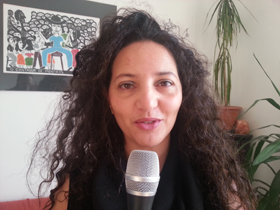 |
Piece-to-camera: Reporter signs off
|
|
NOTES for the CAMERA OPERATOR 1. Keep the shots changing. DON'T get stuck on the interviewee giving an answer. It will be boring! Instead, keep switching to the 2-shot, the mid-shot, and the "noddy" of the reporter. 2. Be quick but smooth when changing shots. Be very steady when you've arrived at the shot.
3. Try to sense the reporter's next question and be in position for her as she starts. 4. Don't forget the 2-shot!
|
NOTES for the REPORTER 1. Keep the interview short (3-5 minutes or less). It helps to ask only 3 questions. 2. Make sure you interrupt with another question if: - the interviewee is going on too long. or the answer is dull or cautious.
- the answer is unclear. Clarify proper names and acronyms, and anything which would not be understood by the general viewer. - the answer is controversial. Be a journalist, not just a publicist, and ask critical questions.
3. Prompt her to say the interesting things she told you in the pre-interview. 4. At the end, ask how viewers can get involved or get further information.
|
Shoot and Go - the mobile phone news report
This template enables you to work on your own. You prepare and memorise a short, structured voice-over: three sentences for three shots, all recorded in a single take.
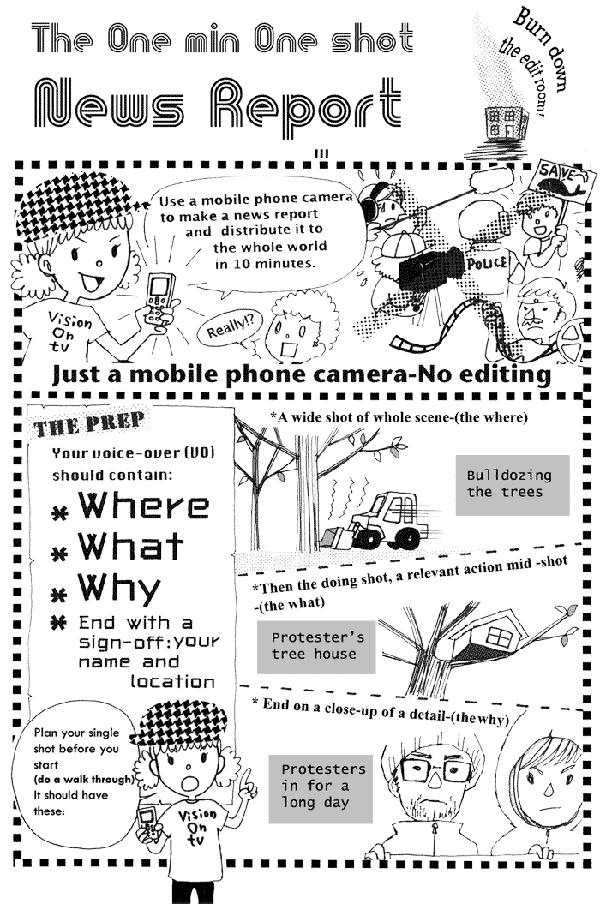
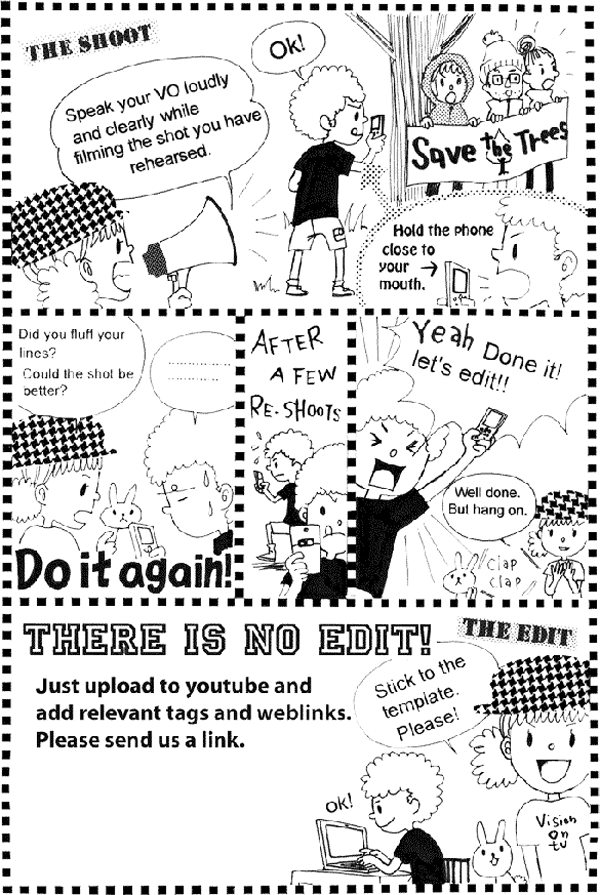
Helpful hints
1. STICK TO THE TEMPLATE!
2. Find your own voice. Do not try to imitate the TV. Make it personal, but tightly worded. While some people are naturals from the outset, finding a style which works for you can take a while. Get out there and practise, make sure you publish the best take from each report, and get some feedback.
3. "My voice sounds weird!" It probably does not. Everyone else will think it sounds just like you.
4. Note that this template is basically 3 still pictures, with a rapid movement between each one. DO NOT let your camera wander!
5. It is good to have an opinion about a subject, but you also want to report to people who are not necessarily on your side, so make sure you talk like a journalist. Be accurate. If you are estimating, say so. Sign off with your real name, so that people can hold you to account. All of this builds trust in citizen media.
6. Do not just describe what people can already see. It's good if your voice-over adds something to the pictures.
7. DO NOT be a perfectionist. It may stop you from getting your news out. "Good enough is good enough." Publish, get feedback, make some more.
Cut and Run - the resuming video template
This template enables you to make a short film "edit-in-camera". You pause the video at the end of a shot, then restart it with the new shot. The end result is a finished film as a single video file composed of different shots, ready for upload.
Technically, this can ONLY be done on Android devices which have a video camera record/PAUSE function. Most devices only allow you to STOP a video clip and start a new one, leaving you with separate video clips. The current roll-out of this feature suggests it is not a priority of manufacturers. For instance, the examples below were taken on a Samsung Galaxy Note II, which gained the function over the original Note. But Galaxy S devices have the ability to pause, but the next generation S II do not. At the time of writing, there is no external app to recommend which adds this function to a device. If you would like to be able to pause video recording, check before you buy.
But even if you are using a phone or tablet without the PAUSE function, it is possible with any device to stitch the shots together in a sequence, using a simple editing programme such as Andromedia (see the Sample intermediate video editor chapter). This means that if you follow this template, you can produce multi-shot videos quickly, whatever your device.
If you can pause video recording, go to the camera screen on your device and select video. Push the record button.
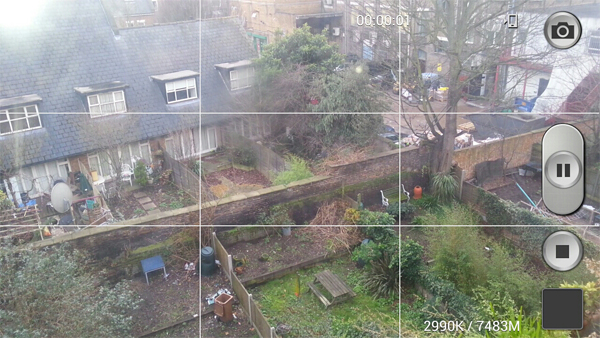
When recording, note the Pause button alongside the Stop button. For this template we will be using the Pause button until the final shot. BE VERY CAREFUL to press Pause throughout, and only press Stop at the end of the final shot.
The basic structure of your report will be this:
ESTABLISHER / ACTION SEQUENCE / MONTAGE / OUT SHOT
We can map this structure to the Shoot and Go template, using the same three sentences. This gives us two options for shooting the report:
OPTION 1: Without voice-over. Only ambient sound. The pictures tell the story.
OPTION 2: With live voice-over, in the style of Shoot and Go.
The report below covers a mass day of action against the austerity policies of the UK government on November 30th 2011. It includes a voice-over, as in Option 2.
 |
(VOICE-OVER in BOLD)
ESTABLISHER - a wide shot (GV) which sets the scene It's 4.30 in the afternoon, Hyde Park, central London. The marchers here are public sector workers who have come out from work on what is Britain's largest strike since 1926. |
 |
ACTION SEQUENCE - People doing something relevant / interesting.
While most people have come to march against the government's austerity policies, the masked activists from Anonymous think that is not enough. |
 |
ACTION SEQUENCE Take this 2nd shot of the sequence as a separate still take. |
 |
MONTAGE - a rapid succession of CLOSE-UP shots and interesting details. An option is to count to the same number (eg one, two) for each shot of the montage, to give a musical rhythm to the sequence. |
 |
Part of MONTAGE |
| Part of MONTAGE
|
|
 |
Part of MONTAGE |
 |
Part of MONTAGE
|
 |
Part of MONTAGE |
 |
GV to finish.
It's estimated that 2 million workers joined the strike today, supported by a wide range of other groups - students, hacktivists, and members of the Occupy movement. This is Sarita Lobato reporting for streetreporter.org
|
Sound continuity problems: It really helps if the ambient sound is reasonably consistent. Music should be avoided, as every cut will cause a nasty sound break. If music is unavoidable, you should cut on the end of a melodic phrase. If there is loud speech, you try to begin at the start of a sentence, and cut at the end of it. This takes a lot of practice. The first few times you do this, try to keep it really simple.
If your device does not pause video recording: Join the shots together in your device's editing programme. See the Sample intermediate video editor chapter for a step-by-step guide.
You are now ready to upload!
An exciting new app
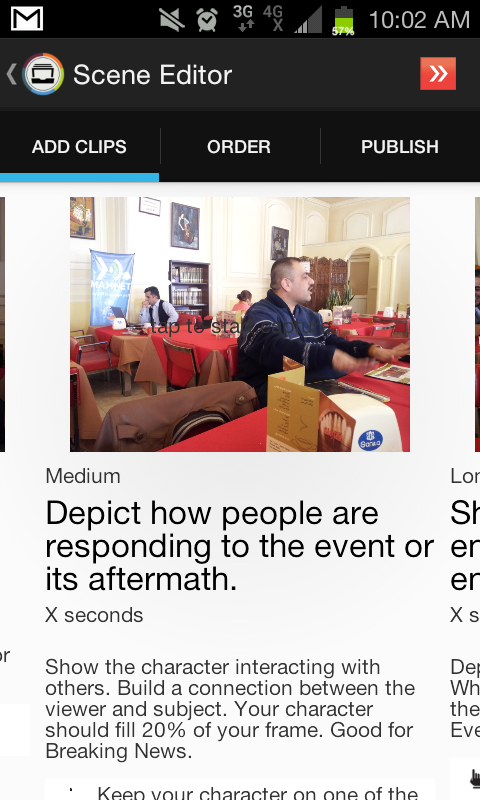
Small World News4 will soon publish a new open source app called Storymaker5 , which will train you in video citizen journalism while you use your device.
It is focussed on enabling existing and aspiring journalists to produce and publish professional-grade news with their Android phone, as safely and securely as possible. There will be an interactive training guide, walk-throughs, and templates for users to follow as they plan their piece and capture media. The app will then help assemble the content into a finished format, with cuts and basic graphics. It will also help you to distribute your stories.